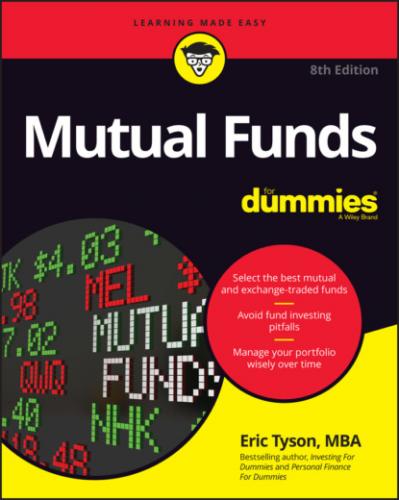Vanguard: Historically, Vanguard has been the low-cost leader with index funds and now has the lowest cost with its ETFs as well. So, if you’re interested in finding out more about ETFs, be sure to examine Vanguard’s ETFs. (www.vanguard.com; 800-662-7447)
iShares: BlackRock has competitive expense ratios on some domestic ETFs based on quality indexes, such as Russell, Morningstar, S&P, Lehman, and Dow Jones. (www.ishares.com; 800-474-2737)
State Street Global Advisors SPDRs: This group uses indexes from Dow Jones, S&P, Russell, and MSCI, among others. (www.ssgafunds.com; 866-787-2257)
Mimicking Closed-End Funds: Unit Investment Trusts
Unit investment trusts (UITs) have much in common with closed-end funds (see Chapter 2). UITs take an amount of money (for example, $100 million) and buy a number of securities (such as 70 large-company U.S. stocks) that meet the objectives of the UIT. Unlike a closed-end fund (and mutual funds in general), however, a UIT does not make any changes to its holdings over time — it simply holds the same, fixed portfolio. This holding of a diversified portfolio can be advantageous because it reduces trading costs and possible tax bills.
Significant upfront commissions: Brokers like to push UITs for the same reason that they like to pitch load mutual funds — for the juicy commission that they ultimately deduct upfront from your investment. Commissions are usually around 5 percent, so for every $10,000 that you invest into a UIT, $500 goes out of your investment and into the broker’s pocket. Although UITs do have ongoing fees, their fees tend to be lower than those of most actively managed mutual funds — they’re typically in the neighborhood of 0.2 percent per year. As an alternative, you can buy excellent no-load funds (see Chapter 7), which, because you’re buying the fund directly from an investment company and without the involvement of a broker, charge you no commission. The best no-load funds also have reasonable management fees, and some charge even less than UITs charge (such as the index funds that I discuss in Chapter 10).
Lack of liquidity: Especially in the first few years after a particular UIT is issued, you won’t readily find an active market in which you can easily sell your UIT. In the event that you can find someone who’s interested in buying a UIT that you’re interested in selling, you may have to sell the UIT at a discount from its actual market value at the time.
Lack of ongoing management oversight: Because UITs buy and hold a fixed set of securities until the UIT is liquidated (years down the road), they’re more likely to get stuck holding some securities that end up worthless. For example, compared to the best bond mutual funds (see Chapter 12), bond UITs have had a greater tendency to end up holding bonds in companies that go bankrupt.
Customizing Your Own Funds Online
On some websites, various services pitch that you can invest in a chosen basket of stocks for a low fee — and without the high taxes and high fees that come with mutual fund investing. Like most political “Vote for me and not my opponent” ads, these services misrepresent both their own merits and the potential drawbacks of funds.
These “create your own funds” services pitch their investment products as a superior alternative to mutual funds. One such service calls its investment vehicles folios, charging you $29 per month ($290 if paid annually) to invest in folios, each of which can hold a few dozen stocks that are selected from the universe of stocks that this service makes available. The fee covers trading in your folios that may only occur during two time windows each day that the stock market is open. The folio service states that orders that are placed between 11 a.m. and 2 p.m. are processed starting at 2 p.m.; orders that are placed between 2 p.m. and 11 a.m. are processed starting at 11 a.m.
So in addition to the burden of managing your own portfolio of stocks, you have virtually no control over the timing of your trades during the trading day. (You can place traditional orders at whatever time the market is open, but you’ll be assessed an additional fee of $3 per trade.)
A site also says, “Mutual funds impose fees that can be very high — and hard to calculate.” I agree with that statement. However, without doing too much homework, an investor can easily avoid high-fee funds. For example, an investor can invest in the best index funds for an annual fee of 0.2 percent per year or less. Thus, an investor would need to have in excess of $150,000 invested through this folio service to come out ahead in terms of the explicit fees.
In addition, you need to be aware of additional fees. One folio service’s website says (in fine print, of course) that it “does charge for certain special services and does receive payment for order flow.” You must be ready to shell out the dough if you
Want to wire money out of your account — $30
Need a copy of a prior statement or transaction — $10
Hold any restricted securities (which are subject to SEC Rule 144) — $75
Close out an account — $50
The site further warns, “Note: These are today’s prices and fees, which are subject to change periodically.”
It seems to me that folio services are geared toward those people who want to hold individual stocks, who trade a lot, and who seek to cap their annual trading costs. Although I prefer investing in the best mutual funds, you can invest in stocks of your own choosing — as long as you do so with a long-term perspective. But if you were going to simply buy and hold individual stocks, why would you want to pay a website-based service $290 per year?
Конец
